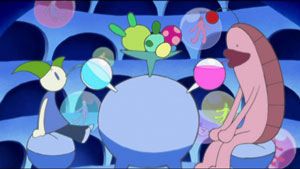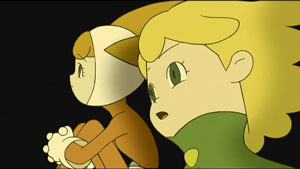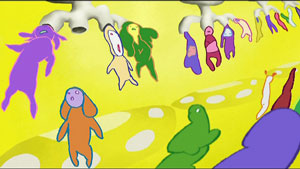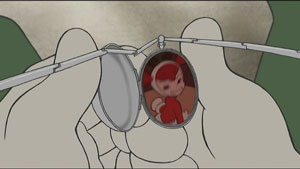Review
by Georgia Blair,Kaiba
DVD Collection
| Synopsis: |  |
||
One day a man, Kaiba, wakes up in a broken room. He has no memories, only a pendant with a picture of an unknown woman. Outside of the room are grotesque floating electrical clouds of disjointed memories. Kaiba is suddenly assaulted, and escapes into space. He travels to various planets, encountering various people and retrieving his memories. Memories of an inconsistent and decaying world, of his own agony and of Niero, the woman in the picture |
|||
| Review: | |||
Anime boomed outside Japan in the last decade, but it permeated the public consciousness long before, and not only in the minds of those who have arguments over whether 'otaku' is a nice thing to call yourself. You can see this initial influence, even though it may be extremely superficial, in animation, comics and pop art--short, kohl-eyed cartoon heroes bearing more resemblance to Astro Boy than Naruto or Haruhi, piloting blocky robots with burning spirit against backdrops of psychedelic colour. Kaiba gives this impression at first glance. Its cartoony character designs, with big hands and goofy sci-fi outfits, hark back to a simpler time, resembling characters Osamu Tezuka, Shotaro Ishinomori or Walt Disney's contemporaries may have created. But the setting they inhabit pays no heed to any anime tropes I can think of. Of all things, it reminds me the most of the claymation computer game The Neverhood. Not a single planet is a perfect sphere. Buildings are asymmetric, organic shapes, as if they grew like mushrooms in the ill-defined landscapes. Colours veer from dull yellows and browns to outright garish, some of the CG effects are obvious to the point of looking cheap, and many scenes are intentionally sketchy and jitter like a nightmarish Japanese version of Roger Ramjet. If you're into anime for hyper-violent fight scenes and moé, just the DVD cover might be enough to turn you off.   The true beauty behind Kaiba's visuals and, I suspect the reason it won an award, is not in how many frames of animation it has, but in the sheer amount of imagination its staff poured into it, and how consistent it remains nonetheless. Lauding such a strange anime for consistency may sound odd, but the bizarre imagery--from fields of blissed-out party animals looking like a little kid's picture, to guns that turns victims to sludge--is as well-thought-out as it is distinct, giving the worlds and characters of Kaiba surprising depth and coherency. Some stories aiming to be surreal or dreamy merely instill the same emotion within me that most of my own, real dreams do, i.e. baffled irritation. Conversely, even at its strangest, Kaiba's art and writing adds to its world-building and mythos, achieving a dreamlike quality without giving the impression of being random for the sake of 'LOL random'. Likewise the soundtrack, with simple but effective music and dreamy, sorrowful vocals, is a perfect match for the setting and the plot's themes of nostalgia and loss.   In Kaiba, memories have physical form and can be shifted from body to body. The rich blithely swap their traumatic memories and ugly bodies for fashionable bodies and blissful memories, flouting the law to buy or steal them from the less fortunate. The first half of the series follows the main character, an amnesiac named Warp, as we learn about his galaxy the way he does, travelling between planets and meeting other troubled by memories. Episode three in particular hammers home the terrible ramifications of the setting--but Warp is less interested in 'fixing' the situation than he is in the blurred photo of a girl in the locket around his neck, the real heart of the story. For in the end, though the identity of Neiro, the girl in the locket, is quickly revealed then not expounded on, Kaiba is a love story. I initially passed the series off as another in the well-established 'protagonist wanders aimlessly and watches people suffer' genre. At the half-way mark however, previously minor characters reveal their motivations and what had seemed like off-hand trivia or things put in because they'd be fun to animate take on very real significance to Warp and Neiro. As the pieces come together, the series builds a sense of urgency until I found myself watching the second DVD in one sitting, eager to know what would become of them. Some may find the denouement anti-climatic, with several plot threads left dangling. One aspect of the final episodes, foreshadowed only slightly, felt a little cliché and tacked on, in my own opinion, but this didn't impede the overall satisfaction I felt as I watched the end credits. Instead of a huge flashy finale (though the climax is plenty action-packed) or the creepy dwindling away seen in one of the director's earlier works, Cat Soup, the story simply comes to an end. I feel this ending was perfect, but it took me a while to come to this conclusion (part of the reason this review took so long!). This is a series that may require deep thought or repeat viewings to truly appreciate.   Siren Visual's DVD release is very bare-bones with no dub track and no extras save for trailers, but the release's only real flaw is occasional quirks in the subtitles, with some Japanese text going without translation. A series relying heavily on its art might have done well with a Blu-ray release but it is understandable that this is probably not viable for a series with such niche appeal. In any case, Siren should be lauded for bringing Kaiba out of Japan. Those who enjoy unique visuals, reflecting upon stories, and something a little different from the norm would do well to pick up Kaiba and support titles that show the full gamut of Japanese animation, to anime nerds and those who watched Astro Boy when they were kids alike. |
|
The views and opinions expressed in this article are solely those of the author(s) and do not necessarily represent the views of Anime News Network, its employees, owners, or sponsors.
|
| Grade: | |||
|
Overall (sub) : A-
Story : A-
Animation : A
Music : B
+ Well-thought-out setting, fascinating visuals, plot builds up as series progresses ⚠ Sexual references, adult themes |
|||
| discuss this in the forum (5 posts) | | |||
| Production Info: | ||
|
Full encyclopedia details about Release information about |
||